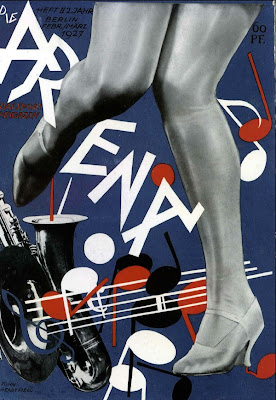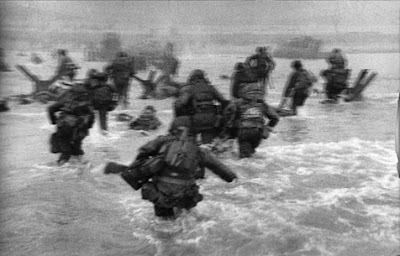
Die Arena
February/March 1927
February/March 1927
This image of a dancing woman's legs was simply a good graphic for the magazine's cover. This is an excellent example of the advertising capabilities of photomontage.
Denonation:Women leg.dark background,symbols of music,large font.
Photomontage:Its good image,joining women leg with the signs of music represents dance in a party.Its showing good combination of music and and dance because you can't dance without music.
The monkey is reading Der Sturmer, an anti-semite newspaper. There is a satirical conversation between the animals.
MONKEY: I read in the paper that some people think Jews are animals, and so forth. Does this mean they will soon be put into the zoo with us?
MONKEY: I read in the paper that some people think Jews are animals, and so forth. Does this mean they will soon be put into the zoo with us?
MARABOU: Phoo! The Jews will be put on church steeples-that’s much more clever!
MONKEY: But tell me why. MARABOU: Because the Jews are the best lightning rods.
Denotation: Monkey,bird,black,brown and white colour.
Connonation: Animals also talk with each other, sound funny.
Photomontage: Its just like people from different races talk & work with each other,animals also do the same.
This piece shows humanity, broken on the wheel. It mirrors the traditional piece with a reference to the swastika, the Third Reich breaking human life.
Denotation: Jesus,dark colours,strong image.
Connotation: Unjustice,unkind,broken heart,life in danger.
Photomontage: Two joined images showing that the world getting cruel day by day.There is no respect left for humanity.
Q:What is Photomontage?
A:Photomontage is the process and result of making a composite photograph by cutting and joining a number of other photographs. The composite picture was sometimes photographed so that the final image is converted back into a seamless photographic print. A similar method, although one that does not use film, is realized today through image-editing software.
A:Photomontage is the process and result of making a composite photograph by cutting and joining a number of other photographs. The composite picture was sometimes photographed so that the final image is converted back into a seamless photographic print. A similar method, although one that does not use film, is realized today through image-editing software.
John Heartflied:John Heartfield (19 June 1891–26 April 1968) is the anglicized name of the German photomontage artist Helmut Herzfeld. He chose to call himself Heartfield in 1916, to criticize the rabid nationalism and anti-British sentiment prevalent in Germany during World War I.
John heartflied work:His photomontages satirising Adolf Hitler and the Nazis often subverted Nazi symbols such as the swastika in order to undermine their propaganda message.
One of his more famous pieces, made in 1935 entitled Hurrah, die Butter ist Alle! (English: Hurray, we have run out of butter!) was published on the frontpage of the AIZ in 1935. A parody of the aesthetics of propaganda, the photomontage shows a family at a kitchen table, where a nearby portrait of Hitler hangs and the wallpaper is emblazoned with swastikas. The family — mother, father, old woman, young man, baby, and dog — are attempting to eat pieces of metal, such as chains, bicycle handlebars, and rifles. Below, the title is written in large letters, in addition to a quote by Hermann Goering during food shortage. Translated, the quote reads: "Iron has always made a nation strong, butter and lard have only made the people fat".:
One of his more famous pieces, made in 1935 entitled Hurrah, die Butter ist Alle! (English: Hurray, we have run out of butter!) was published on the frontpage of the AIZ in 1935. A parody of the aesthetics of propaganda, the photomontage shows a family at a kitchen table, where a nearby portrait of Hitler hangs and the wallpaper is emblazoned with swastikas. The family — mother, father, old woman, young man, baby, and dog — are attempting to eat pieces of metal, such as chains, bicycle handlebars, and rifles. Below, the title is written in large letters, in addition to a quote by Hermann Goering during food shortage. Translated, the quote reads: "Iron has always made a nation strong, butter and lard have only made the people fat".:






